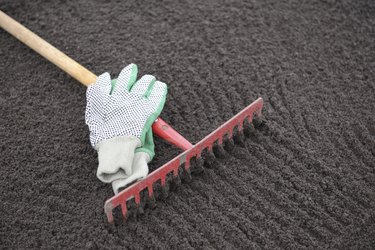Leveling a flowerbed on uneven or slightly sloping terrain is a fairly simple task. With some simple hand tools and a few other items, it's a job you should be able to complete in a number of manageable steps. Although it can certainly be a one-person project, a helper would make the job a bit easier.

Video of the Day
Things You'll Need
Stakes
Hammer or sledgehammer
Mason’s twine
Line level
Pencil or permanent marker
Shovel
Garden rake
Soil (optional)
Setting Up the Lines
Step 1
Drive stakes into the ground to mark the perimeter of your flowerbed. If the bed is rectangular, four stakes are enough. If your bed is irregular in shape, then use enough stakes to outline the shape.
Video of the Day
Step 2
Tie mason's twine securely, at ground level, to the stake that appears to be at the highest corner or point of your flowerbed.
Step 3
Run the twine from the highest corner's stake to and around the next stake, then to and around the following stake and so on until you've reached the stake at the starting point. Tie the twine securely again at ground level at that stake, which is the starting stake.
Tip
While running the twine around the stakes, try to keep it roughly level, just by eye, between each stake. Also, keep enough tension on the twine to prevent it from sagging, but not so much tension that it pulls on the stakes too much.
Leveling the Lines
Step 1
Hang a line level on the mason's twine in the midsection of the first span of twine after the starting stake. The line level has small hangers or clips for attaching it to the mason's twine. Check the line level's bubble position.
Step 2
Adjust the twine upward or downward as necessary where it makes its turn around the first stake after the starting stake. Do this until the line level's bubble is centered.
Step 3
Remove the line level, being careful not to move the twine out of adjustment, and hang it on the midsection of the next leg of twine. Adjust the twine up or down, if necessary, on the next stake to achieve a centered, or level, bubble reading in the line level.
Step 4
Repeat the line level placement and the checking and adjustment of each section of twine between the remaining stakes until all the sections of twine are level. Recheck previous twine sections to ensure they didn't go out of level.
Step 5
Make a mark with a pencil or permanent marker on each stake right at the spot where the twine passes around it after you've confirmed that each segment of the twine is level.
Grading the Soil
Step 1
Move and distribute soil within the flowerbed perimeter formed by the twine, using a shovel and garden rake to begin making the soil level. Use either the soil that is in place or, if necessary, bring it in from elsewhere.
Step 2
Continue distributing the soil throughout the flowerbed until the soil surface appears to be about even with the level marks you made on the stakes. Once the soil's rough grade is established, use the rake to give it a finer surface and to flatten high spots.
Tip
After the level marks are on the stakes, you can remove the twine temporarily if it’s in the way when you shovel and rake soil. Just ensure the stakes are set securely in the ground so that the level marks on them don't move.
Step 3
Bring the soil surface up to the level marks on the stakes and as flat across the flowerbed as you can get it. Put the twine around the stakes again, if you removed the twine, and tie it taut, as you did previously.
Step 4
Tie one end of a separate length of twine to any one of the stakes. Tie that twine right at the selected stake's level mark, and make ensure the twine piece is long enough to span the whole flowerbed just beyond the bed's widest point. Lay this new twine piece, twine line, outside the flowerbed's original twine perimeter.
Step 5
Draw the loose end of the twine line that you just tied to one stake across the entire bed periodically as you distribute the soil in the bed. Stand outside the flowerbed perimeter, and pull the new twine line just enough so that it doesn't sag. Sweep the twine line around and between the stakes while gently bringing it downward into contact with the level perimeter twine. This sweeping line will reveal the high and low spots across the whole bed as you spread and rake soil.
Step 6
Continue grading and checking until the soil surface is up to and even with the sweeping line throughout the flowerbed. Remove the stakes and twine.
Tip
After you finish, and after the soil settles for one or two days -- especially if rain falls or you water the bed, you might find it necessary to regrade the soil surface slightly one last time or bring it up a little. In this case, you could leave the stakes and twine in place for a while.
For more information on readying your soil for new arrivals, see How to Prepare the Soil for a New Flower Bed.